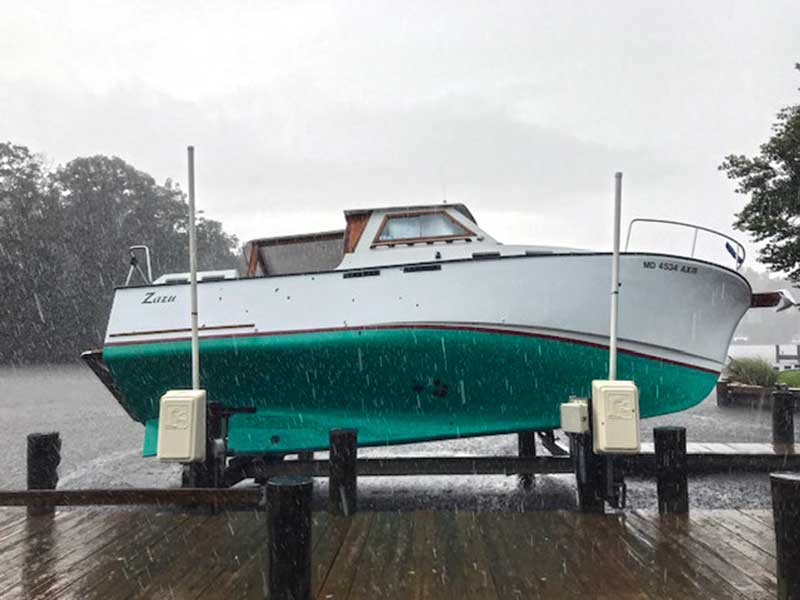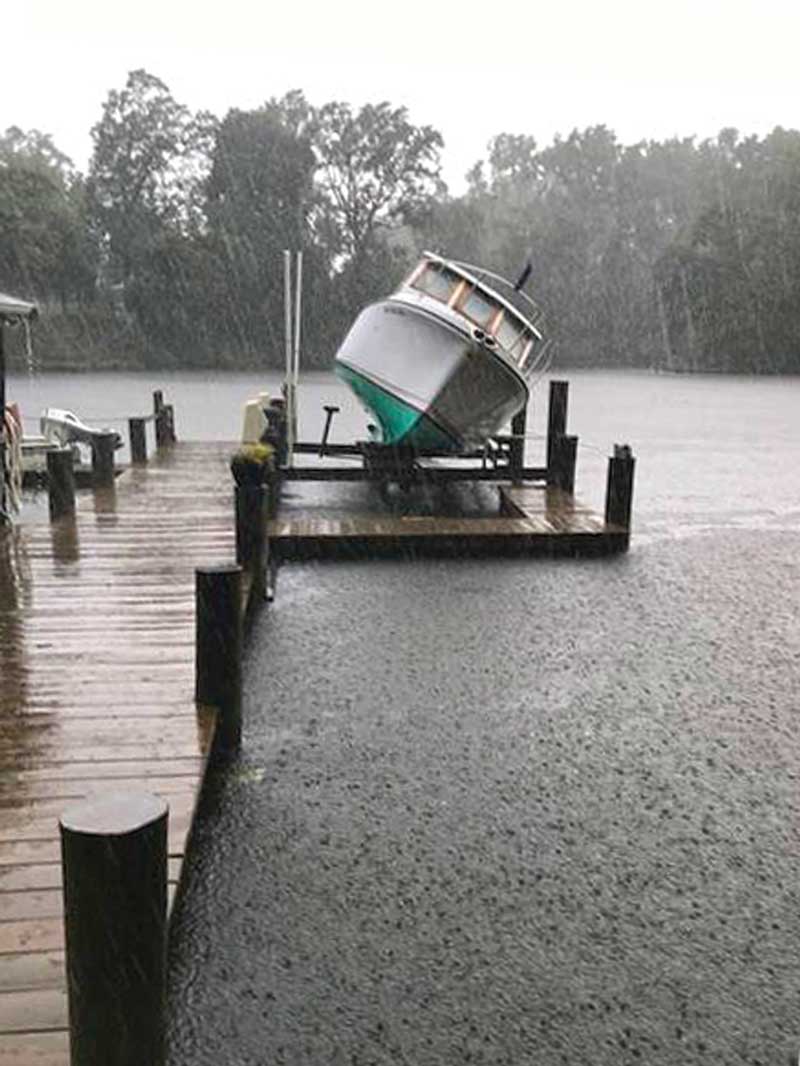You never expect to be the bull’s eye for a tornado and be standing three feet from the powerful edge. This article is to walk you through the process and share some of what goes through your mind, and some surprises I learned.

I live on a point on a creek off the South River near the Route 2 Bridge. September 3, 2020 was a beautiful day. Blue skies, gentle breeze. There were some possible rain clouds to the west, but we often see clouds that stay to our west and then curve to our north over Annapolis. So, no problem. My big decision that afternoon was whether to mow the grass or take a boat ride… Boat ride!
In the two minutes or so it took to walk to the top of the stairs down to my dock, I was just about to put my hand on the handrail when I saw seemingly small, isolated clouds coming down the creek to my dock and point. It had a slightly beige tint (dust?) and definable edges (like a cloud bank). I saw it pass a few feet away from my neighbor’s outer piling with no effect. No particular sounds either.
Within seconds, the handrail I was about to grip suddenly ripped off like a beer can tab. Let me stress the sudden force this takes, which a neighbor’s measurement estimated to be close to 100 mph.
The handrail was my biggest shock. When a tree had fallen across the stairway a few years ago, I had it replaced and insisted that it be “strong enough to stop a tank.” Everything was double or triple strength. So, what happened?
This was the start of my surprises. For the handrail to be ripped up in a matter of seconds was my biggest eye-opener. Then I realized that all along I was standing three feet from the wind and damage. However, I have no memory or indication of feeling the wind. The lesson (and proven elsewhere in this story) is that a tornado is like your leaf-blower. Wherever the leaf blower is aimed, almost anything is blown away. However, a few inches from where the blower is aimed… no blowing effect.
All of this happened in a few seconds. Then I heard the cracking and crashing of the tops and big branches of several large trees a few feet away on the point.
Only then did I look down at the dock. My four-ton trawler, Zazu, (on its six-ton capacity lift) was lying about 90 degrees on its side. It had been flipped in one puff like a child’s toy in a bathtub. I think that the wind hit Zazu’s significant windage from the side, coupled with a downburst, because one of the small I-beam vertical braces was sheared off. That crashing over led to one softball-sized hole from another vertical pole on the lift, and two other smaller gashes. The good news was that the boat was not in the water, and the big hole turned out to be a few inches above the waterline, so we could float her off and let the lift crew get that back in shape.
The Aftermath

I cannot say enough praise for repair saviors. My body had come through unscathed, but I think I was ready for a nervous breakdown the next morning as I stood on the dock feeling helpless. Repairing the hull was a top priority, as was fixing the lift. I made two calls. Chris Michaels of Boat Lifts Unlimited appeared on my dock in 20 minutes. Minutes later, Marvin Muir of South River Boat Cosmetics appeared. He had been recommended by a friend, and I had cold-called. They did a fantastic job!
I also learned an important lesson about having your job proceed efficiently and well. The professionals need to be able to do their job. If Marvin hadn’t instantly gotten the boat off the lift, and even did a starter fix from a blow-up work platform, Chris would have had to put my job down the list until the lift was ready. So, the lesson is to be proactive in helping in any way to have everything ready for the pros. I think I was fully repaired much faster from that.
Back to surprises regarding the dock and other boats. In the direct path of the tornado, just six feet from Zazu, was tied my 18-foot low-slung center console. You’d think that it would have been sunk, slammed against pilings or the dock.
Nope! The center console was floating like a calm swan. The dock lines had gotten quite frazzled, but the slip-on covers for the console and the seat looked untouched. My guess is that the main force of the wind was about five feet above the water.
A few feet away, on a covered porch of the dock house, was a dinghy RIB with an outboard. The plastic cover looked like a flag that had flown too long, but the boat, though on the side of the dock house adjacent to the wind, was only a couple of feet away from Zazu and the lift.
Meanwhile, a surprise was that there was an overturned heavy canoe stored along the back wall of the dockhouse. I assumed it would have been blocked from the wind. However, it went airborne with such thrust that it ripped out one cleat and broke the other end’s tie-down. The canoe’s flight had been up, about 10 feet over the dock, and then about 20 feet over the water where it was left hanging on a piling on a section of bulkhead. It must have been all flight, because there was no water inside or signs of it being there, and no scratch marks. However, the flight and landing did pull out two thwarts, but I was able to fix that.
Some general parting thoughts
Everything is unpredictable. It was a gorgeous day. The damage path was narrow. Fifty feet to the right, and a large portion of my house would be clobbered.
Read and understand your home and boat insurance policies very carefully and understand precisely what it does and doesn’t cover. Policies and insurers vary, but don’t expect to start having money sent right away. You will also find out the many idiosyncrasies about coverage.
I hope you never need to use these hints.
By Fred Hunt